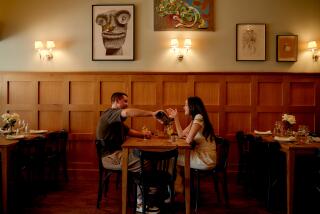TASTE MAKERS : People Who Shape and Define Matters of Taste : ALICE WATERS : THE QUEEN OF CALIF. CUISINE
BERKELEY â Eight people in white are chopping, slicing, peeling, pounding, stirring and grinding. Thereâs garlic in the Cuisinart and squab stock in the huge pot on the floor. Itâs almost dinner time at Chez Panisse, the 14-year-old restaurant that has made chef Alice Waters the doyenne of American cooking and defined what became known as California Cuisine.
The tiny, 41-year-old restaurateur has been mentor and former employer to such celebrity chefs as Jeremiah Tower, Mark Peel and Jonathan Waxman. In this tree-shaded house on a busy street, next door to a cleaners and down the street from both the Synergy Power Institute and the Jungian Dreamwork Institute, Waters profitably launched her idea of good cooking: âhaving the freshest ingredients you could find, and then doing as little as possible to them.â
Swathed in black, her daughter Fanny balanced on her hip, Waters is heartened by a national health-consciousness that is sending people back to foods that taste good and are good for them. But she wants more: âAll the fast food chains put out of business, that everybody has something growing in his back garden . . . and that nobody will be eating foods out of season.â
She started early, sent off to a party at age 3 wearing radish bracelets, a strawberry necklace and a lettuce-leaf skirt from her parentsâ Victory Garden. In her first cookbook, published in 1982 and already in its ninth printing, she confesses that salad tastes best to her straight from the kitchen sink. She still eats lettuce with her fingers, even in her restaurant.
Naturalness appears to be her touchstone. Her hair is short, her attractive round face relatively free of make-up, her clothing dramatic but simple. Her refrigerator at home didnât even have a freezer until recently and she credits her husband of three months--wine merchant and artist Stephen Singer--with bringing her into the 20th Century with âa more utilitarian refrigerator,â not to mention a VCR.
Waters never studied cooking nor worked in a restaurant, and her life is clearly powered by some sort of spontaneous combustion. She explains that there was no real plan of restaurant expansion, for instance, but rather what she calls âorganicâ growth. Chez Panisseâs open kitchen has been widely copied, but the notion of a highly visible kitchen came about when the restaurant was rebuilt following a fire four years ago rather than from any master plan.
New Jersey-born and raised, Waters first went to France at 19 to study French culture at the Sorbonne. She couldnât speak French, had yet to taste an oyster. But when she got there, she simply âfell in love with the cooking and the way people ate. With the cafe life.â She came home, finished school and later worked as a Montessori teacher while feeding a continual flow of dinner guests.
She was also a â60s Berkeley radical, and many of her political feelings carried over to food. Her goal was an environment where people could come and talk about the politics of the day, and Chez Panisse sought to establish what one journalist called âa culinary extended family.â Waters added the upstairs cafe in 1979 when downstairs got too pricey and crowded for her friends, then added the new stand-up, chairless Cafe Fanny (across town) when Cafe Panisse got too popular.
About 100 people an evening pay $40 apiece for Chez Panisseâs five-course daily meal, whatever it is, and it is different every night. Chefs have been known to experiment with ingredients minutes before meals are served, and Waters is as likely to include edible flowers in her foods as to concoct something like wine-spiced garlic sherbets for a garlic festival meal.
Cafe Panisseâs open grill upstairs was inspired by memories of childhood barbecues as much as by an open grill Waters lunched at more recently in Turin, Italy. One restaurant menu was created for the 100th birthday of Alice B. Toklas, another was designed around the titles of M.F.K. Fisherâs books, still another inspired by a friendâs description of a dinner she had eaten in Kyoto, Japan.
Waters is clearly obsessed by the work of French film maker Marcel Pagnol, particularly his â30s trilogy about the Marseilles waterfront: âFanny,â âCesarâ and âMarius.â There was a Pagnol film festival in San Francisco just before her restaurant opened, and the restaurantâs name comes from Pagnolâs kindly sail maker, Panisse.
At a weekend retreat for employees in November she even screened the trilogy âso that all the people involved with the restaurant could touch base with the source.â And she was so âtotally influencedâ by Pagnolâs memoirs that she hopes to publish an English-language edition to celebrate Chez Panisseâs 15th anniversary next year.
There are Pagnol-inspired posters on the walls of the more casual Cafe Panisse upstairs, but the walls are bare at Chez Panisse downstairs. There, the mood is established by the food that comes out of the kitchen and by the reed willows and snow princess lilies in the huge copper pots around the dining room. Waters spends $60,000 a year on seasonal flowers, saying: âIf the flowers are special, it gives you a sense you might eat something special.â
The restaurateur is spending more time at home these days, enjoying her daughter, now âgoing into the terrible twos.â Waters is working on her fourth book project, an Italian cookbook with Panisse chef Paul Bertolli, and recently made a proposal to the Oakland Museum for what she calls a âfood galleryâ exhibition.
More to Read
Eat your way across L.A.
Get our weekly Tasting Notes newsletter for reviews, news and more.
You may occasionally receive promotional content from the Los Angeles Times.










